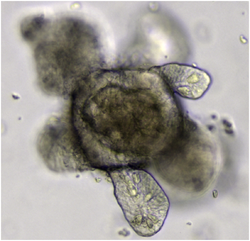Primary cell culture
| Primary cell culture | |
|---|---|
 Primary interstinal organoid culture | |
| Identifiers | |
| MeSH | D061251 |
| Anatomical terminology | |
Primary cell culture is the ex vivo culture of cells freshly obtained from a multicellular organism, as opposed to the culture of immortalized cell lines. In general, primary cell cultures are considered more representative of in vivo tissues than cell lines, and this is recognized legally in some countries such as the UK (Human Tissue Act 2004).[1] However, primary cells require adequate substrate and nutrient conditions to thrive and after a certain number of divisions they acquire a senescent phenotype, leading to irreversible cell cycle arrest.[2] The generation of cell lines stems from these two reasons. Primary cells can become immortalized either spontaneously (e.g. HeLa cells) or by genetic modification (e.g. HEK cells), at which point they become cell lines which can be subcultured indefinitely.[3]
Because of their requirements for viability, primary cell cultures did not become widespread until the 2000s. These cultures present several advantages over cell lines, including a better representation of the cellular heterogeneity of tissues, a more faithful transcriptomic and proteomic profile (especially when cultured in 3D) and more realistic functional responses, including drug responses.[4][5][6] In contrast, immortalized cell lines are known to become homogeneous through the natural selection of specific subpopulations, to undergo genetic drift and to acquire genetic aberrations. In many cases, cell lines have been misidentified, contaminated with other cells or infected with Mycoplasma, small intracellular bacteria that went undetected for decades.[4][7]
When whole or partial tissues are isolated and maintained ex vivo, the procedure is termed primary tissue culture. More specific terms include organotypic culture,[8] tissue slices[9] and explants.[10]
See also[]
- 3D cell culture
- Induced pluripotent stem cell
- Patient-derived xenograft
References[]
- ^ Geraghty, R J; Capes-Davis, A; Davis, J M; Downward, J; Freshney, R I; Knezevic, I; et al. (September 2014). "Guidelines for the use of cell lines in biomedical research". British Journal of Cancer. 111 (6): 1021–1046. doi:10.1038/bjc.2014.166. PMC 4453835. PMID 25117809.
- ^ Campisi, Judith; d'Adda di Fagagna, Fabrizio (September 2007). "Cellular senescence: when bad things happen to good cells". Nature Reviews Molecular Cell Biology. 8 (9): 729–740. doi:10.1038/nrm2233. PMID 17667954. S2CID 15664931.
- ^ Freshney, R. Ian; Freshney, Mary G., eds. (1996). Culture of immortalized cells. New York: Wiley-Liss. ISBN 978-0-471-12134-3.
- ^ a b Gillet, J.-P.; Varma, S.; Gottesman, M. M. (3 April 2013). "The Clinical Relevance of Cancer Cell Lines". JNCI Journal of the National Cancer Institute. 105 (7): 452–458. doi:10.1093/jnci/djt007. PMC 3691946. PMID 23434901.
- ^ Cree, Ian A; Glaysher, Sharon; Harvey, Alan L (August 2010). "Efficacy of anti-cancer agents in cell lines versus human primary tumour tissue". Current Opinion in Pharmacology. 10 (4): 375–379. doi:10.1016/j.coph.2010.05.001. PMID 20570561.
- ^ Tiriac, Hervé; Belleau, Pascal; Engle, Dannielle D.; Plenker, Dennis; Deschênes, Astrid; Somerville, Tim D. D.; et al. (September 2018). "Organoid Profiling Identifies Common Responders to Chemotherapy in Pancreatic Cancer". Cancer Discovery. 8 (9): 1112–1129. doi:10.1158/2159-8290.CD-18-0349. PMC 6125219. PMID 29853643.
- ^ American Type Culture Collection Standards Development Organization Workgroup (June 2010). "Cell line misidentification: the beginning of the end". Nature Reviews Cancer. 10 (6): 441–448. doi:10.1038/nrc2852. PMID 20448633. S2CID 1904739.
- ^ Vaira, V.; Fedele, G.; Pyne, S.; Fasoli, E.; Zadra, G.; Bailey, D.; et al. (4 May 2010). "Preclinical model of organotypic culture for pharmacodynamic profiling of human tumors". Proceedings of the National Academy of Sciences. 107 (18): 8352–8356. doi:10.1073/pnas.0907676107. PMC 2889536. PMID 20404174.
- ^ Meijer, Titia G; Naipal, Kishan AT; Jager, Agnes; van Gent, Dik C (May 2017). "Ex vivo tumor culture systems for functional drug testing and therapy response prediction". Future Science OA. 3 (2): FSO190. doi:10.4155/fsoa-2017-0003. PMID 28670477.
- ^ Carranza-Torres, Irma Edith; Guzmán-Delgado, Nancy Elena; Coronado-Martínez, Consuelo; Bañuelos-García, José Inocente; Viveros-Valdez, Ezequiel; Morán-Martínez, Javier; et al. (2015). "Organotypic Culture of Breast Tumor Explants as a Multicellular System for the Screening of Natural Compounds with Antineoplastic Potential". BioMed Research International. 2015: 1–13. doi:10.1155/2015/618021. PMC 4449881. PMID 26075250.
- Cell culture